Abstract
Gradient-purified resting B lymphocytes can be polyclonally stimulated by antigen-specific major histocompatibility complex (MHC)-restricted helper T lymphocytes as well as by antigen-activated helper T-cell supernatant. In contrast to what has been described so far, we show that helper T-cell supernatant (in the absence of any other added stimulus, such as that provided by anti-mu antibodies) is sufficient to induce both proliferation of resting B cells and their differentiation into IgM-secreting cells. The stimulation induced by the helper T-cell supernatant takes place in serum-free medium and is not MHC-restricted. Our findings strongly support the existence of a B-cell activating factor acting on the resting B cell and causing it to enter the G1 phase of the cell cycle in a MHC-unrestricted manner.
Full text
PDF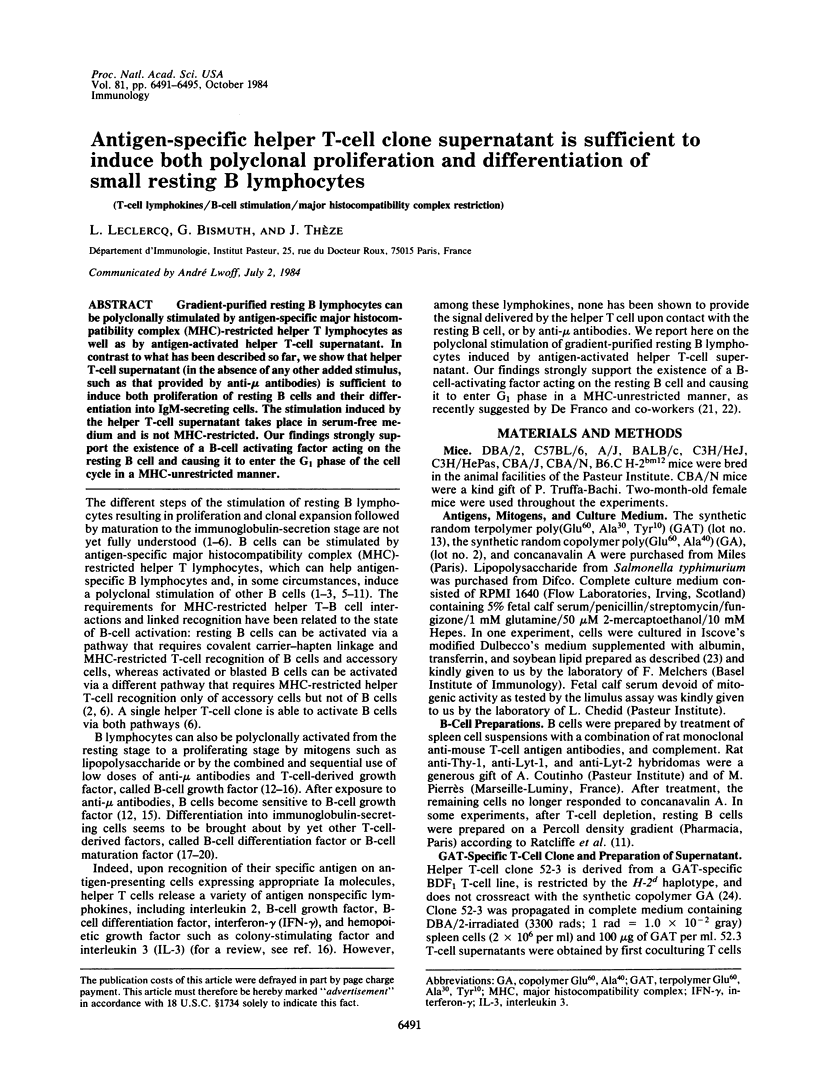
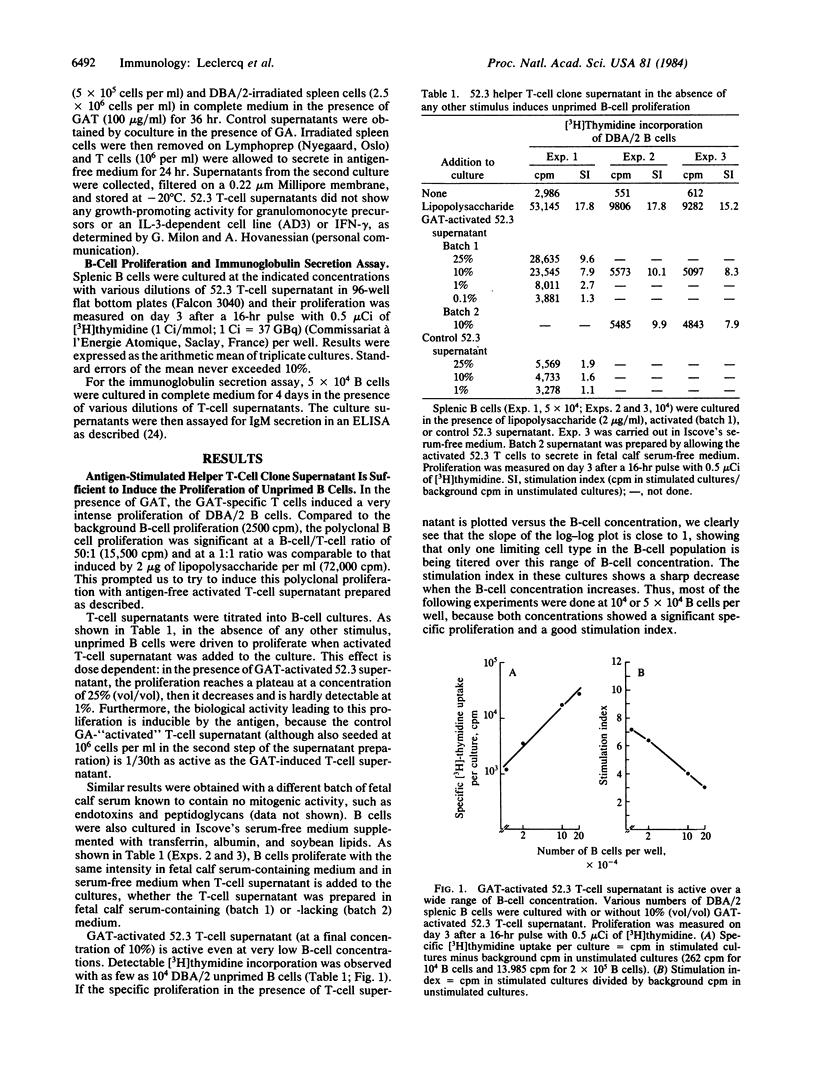
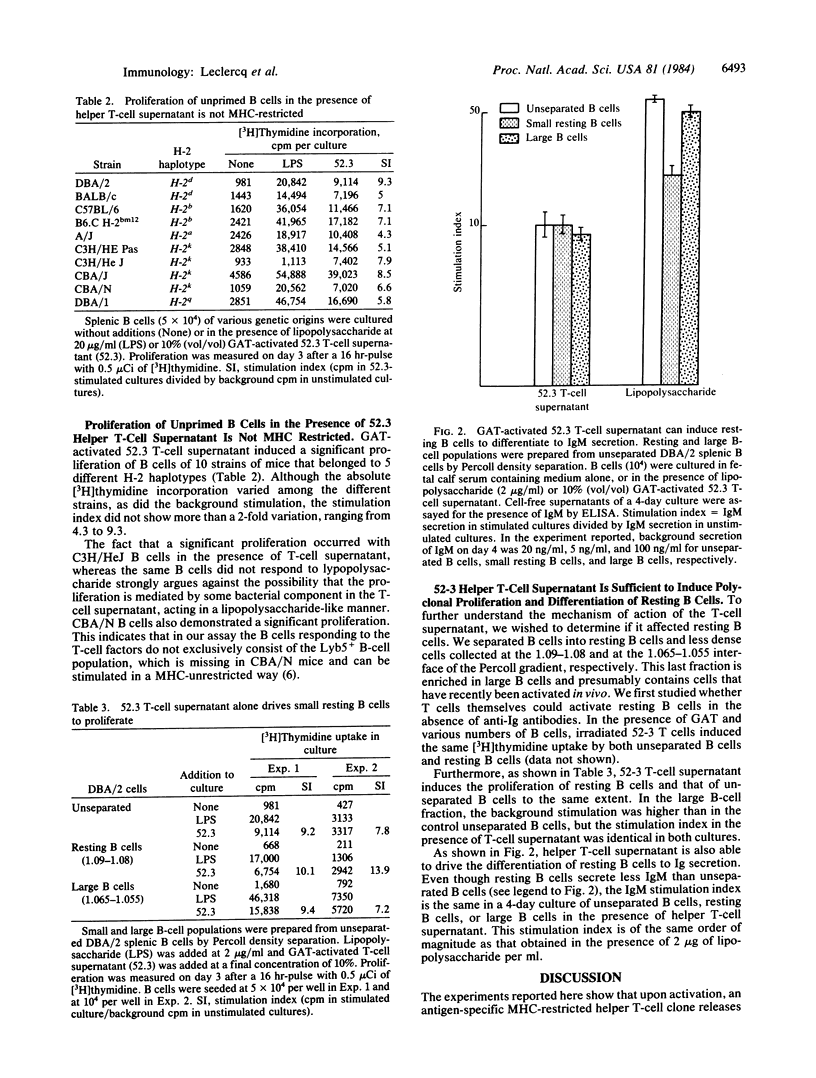
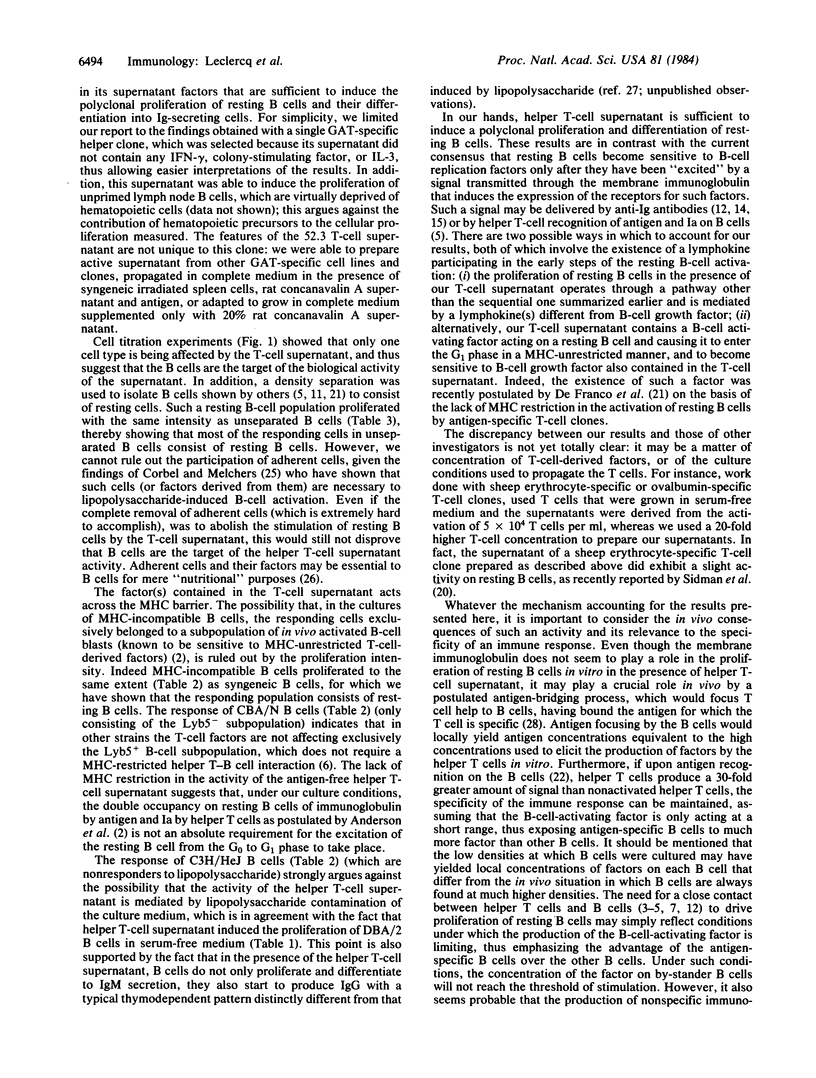
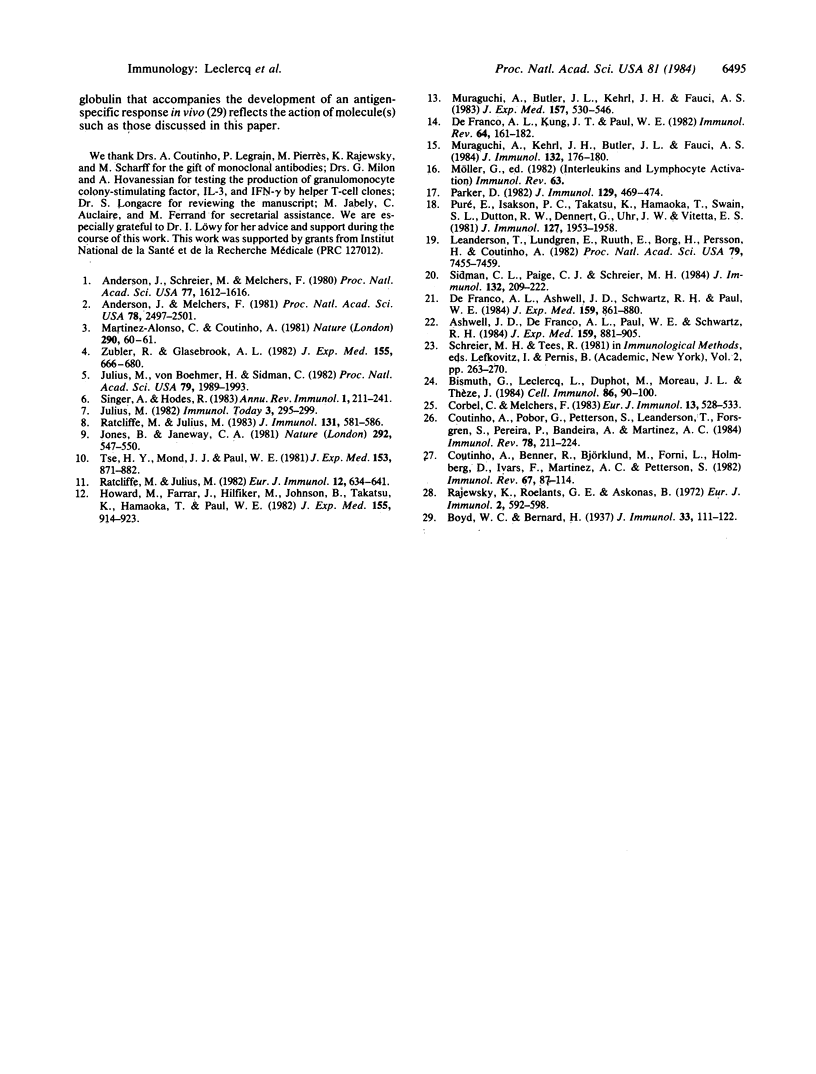
Selected References
These references are in PubMed. This may not be the complete list of references from this article.
- Anderson J., Melchers F. T cell-dependent activation of resting B cells: requirement for both nonspecific unrestricted and antigen-specific Ia-restricted soluble factors. Proc Natl Acad Sci U S A. 1981 Apr;78(4):2497–2501. doi: 10.1073/pnas.78.4.2497. [DOI] [PMC free article] [PubMed] [Google Scholar]
- Andersson J., Schreier M. H., Melchers F. T-cell-dependent B-cell stimulation is H-2 restricted and antigen dependent only at the resting B-cell level. Proc Natl Acad Sci U S A. 1980 Mar;77(3):1612–1616. doi: 10.1073/pnas.77.3.1612. [DOI] [PMC free article] [PubMed] [Google Scholar]
- Ashwell J. D., DeFranco A. L., Paul W. E., Schwartz R. H. Antigen presentation by resting B cells. Radiosensitivity of the antigen-presentation function and two distinct pathways of T cell activation. J Exp Med. 1984 Mar 1;159(3):881–905. doi: 10.1084/jem.159.3.881. [DOI] [PMC free article] [PubMed] [Google Scholar]
- Bismuth G., Leclercq L., Duphot M., Moreau J. L., Theze J. In vitro induction and expression of interleukin 2 receptor in a clonal T helper cell differentiation model. Cell Immunol. 1984 Jun;86(1):90–100. doi: 10.1016/0008-8749(84)90362-9. [DOI] [PubMed] [Google Scholar]
- Corbel C., Melchers F. Requirement for macrophages or for macrophage- or T cell-derived factors in the mitogenic stimulation of murine B lymphocytes by lipopolysaccharides. Eur J Immunol. 1983 Jul;13(7):528–533. doi: 10.1002/eji.1830130703. [DOI] [PubMed] [Google Scholar]
- Coutinho A., Pobor G., Pettersson S., Leandersson T., Forsgren S., Pereira P., Bandeira A., Martinez C. T cell-dependent B cell activation. Immunol Rev. 1984 Apr;78:211–224. doi: 10.1111/j.1600-065x.1984.tb00483.x. [DOI] [PubMed] [Google Scholar]
- DeFranco A. L., Ashwell J. D., Schwartz R. H., Paul W. E. Polyclonal stimulation of resting B lymphocytes by antigen-specific T lymphocytes. J Exp Med. 1984 Mar 1;159(3):861–880. doi: 10.1084/jem.159.3.861. [DOI] [PMC free article] [PubMed] [Google Scholar]
- DeFranco A. L., Kung J. T., Paul W. E. Regulation of growth and proliferation in B cell subpopulations. Immunol Rev. 1982;64:161–182. doi: 10.1111/j.1600-065x.1982.tb00423.x. [DOI] [PubMed] [Google Scholar]
- Howard M., Farrar J., Hilfiker M., Johnson B., Takatsu K., Hamaoka T., Paul W. E. Identification of a T cell-derived b cell growth factor distinct from interleukin 2. J Exp Med. 1982 Mar 1;155(3):914–923. doi: 10.1084/jem.155.3.914. [DOI] [PMC free article] [PubMed] [Google Scholar]
- Jones B., Janeway C. A., Jr Cooperative interaction of B lymphocytes with antigen-specific helper T lymphocytes is MHC restricted. Nature. 1981 Aug 6;292(5823):547–549. doi: 10.1038/292547a0. [DOI] [PubMed] [Google Scholar]
- Julius M. H., von Boehmer H., Sidman C. L. Dissociation of two signals required for activation of resting B cells. Proc Natl Acad Sci U S A. 1982 Mar;79(6):1989–1993. doi: 10.1073/pnas.79.6.1989. [DOI] [PMC free article] [PubMed] [Google Scholar]
- Leanderson T., Lundgren E., Ruuth E., Borg H., Persson H., Coutinho A. B-cell growth factor: distinction from T-cell growth factor and B-cell maturation factor. Proc Natl Acad Sci U S A. 1982 Dec;79(23):7455–7459. doi: 10.1073/pnas.79.23.7455. [DOI] [PMC free article] [PubMed] [Google Scholar]
- Muraguchi A., Butler J. L., Kehrl J. H., Fauci A. S. Differential sensitivity of human B cell subsets to activation signals delivered by anti-mu antibody and proliferative signals delivered by a monoclonal B cell growth factor. J Exp Med. 1983 Feb 1;157(2):530–546. doi: 10.1084/jem.157.2.530. [DOI] [PMC free article] [PubMed] [Google Scholar]
- Muraguchi A., Kehrl J. H., Butler J. L., Fauci A. S. Sequential requirements for cell cycle progression of resting human B cells after activation by anti-Ig. J Immunol. 1984 Jan;132(1):176–180. [PubMed] [Google Scholar]
- Parker D. C. Separable helper factors support B cell proliferation and maturation to Ig secretion. J Immunol. 1982 Aug;129(2):469–474. [PubMed] [Google Scholar]
- Puré E., Isakson P. C., Takatsu K., Hamaoka T., Swain S. L., Dutton R. W., Dennert G., Uhr J. W., Vitetta E. S. Induction of B cell differentiation by T cell factors. I. Stimulation of IgM secretion by products of a T cell hybridoma and a T cell line. J Immunol. 1981 Nov;127(5):1953–1958. [PubMed] [Google Scholar]
- Rajewsky K., Roelants G. E., Askonas B. A. Carrier specificity and the allogeneic effect in mice. Eur J Immunol. 1972 Dec;2(6):592–598. doi: 10.1002/eji.1830020622. [DOI] [PubMed] [Google Scholar]
- Ratcliffe M. J., Julius M. H. H-2-restricted T-B cell interactions involved in polyspecific B cell responses mediated by soluble antigen. Eur J Immunol. 1982 Aug;12(8):634–641. doi: 10.1002/eji.1830120803. [DOI] [PubMed] [Google Scholar]
- Ratcliffe M. J., Julius M. H. Two classes of bystander B cell response: activation requirements reflect those of B cells in general. J Immunol. 1983 Aug;131(2):581–586. [PubMed] [Google Scholar]
- Sidman C. L., Paige C. J., Schreier M. H. B cell maturation factor (BMF): a lymphokine or family of lymphokines promoting the maturation of B lymphocytes. J Immunol. 1984 Jan;132(1):209–222. [PubMed] [Google Scholar]
- Singer A., Hodes R. J. Mechanisms of T cell-B cell interaction. Annu Rev Immunol. 1983;1:211–241. doi: 10.1146/annurev.iy.01.040183.001235. [DOI] [PubMed] [Google Scholar]
- Tse H. Y., Mond J. J., Paul W. E. T lymphocyte-dependent B lymphocyte proliferative response to antigen. I Genetic restriction of the stimulation of B lymphocyte proliferation. J Exp Med. 1981 Apr 1;153(4):871–882. doi: 10.1084/jem.153.4.871. [DOI] [PMC free article] [PubMed] [Google Scholar]
- Zubler R. H., Glasebrook A. L. Requirement for three signals in "T-independent" (lipopolysaccharide-induced) as well as in T-dependent B cell responses. J Exp Med. 1982 Mar 1;155(3):666–680. doi: 10.1084/jem.155.3.666. [DOI] [PMC free article] [PubMed] [Google Scholar]


